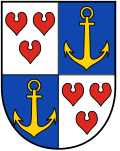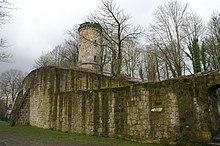County of Tecklenburg
|
Territory in the Holy Roman Empire |
|
|---|---|
| County of Tecklenburg | |
| coat of arms | |

|
|
| map | |

|
|
| County of Tecklenburg with Rheda, 1560
|
|
| Form of rule | monarchy |
| Ruler / government |
Count
|
| Reichskreis | Lower Rhine-Westphalian |
| Capitals / residences | Tecklenburg |
| Dynasties | Bentheim-Tecklenburg |
| Language / n | German |
| surface | 330 km²
|
The county of Tecklenburg was a territory of the Holy Roman Empire. It was in the Westphalian Empire and was 330 km² in size. Since 1707 the county was part of Brandenburg-Prussia .
history
Around Tecklenburg Castle in the southwest of Osnabrück , Ekbert I and the following Counts of Tecklenburg built an extensive territory between the rivers Hunte and Ems . Until 1173 the counts owned the bailiwick of the diocese of Münster . Between 1180 and 1236 they were also owned by the Bailiwick of the Osnabrück diocese . At that time, the county was the strongest power in this area alongside rival Ravensberg county . In the struggle for power at the imperial level in the 12th and 13th centuries, the Tecklenburg supporters of Lothar von Süpplingenburg and the Guelphs . Simon I acquired the rule of Ibbenbüren in 1189 .
After the Counts of Tecklenburg died out in 1262, the county passed to the Counts of Bentheim . Between 1328 and 1562 it belonged to the Counts of Schwerin . In 1365 they were able to acquire the rule of Rheda . However, in 1400 they lost the northern parts of the county with the offices of Cloppenburg , Friesoythe and Bevergern to the bishopric of Münster . From then on, the state estates were represented in the county’s state parliament by only ten goods eligible for state parliament: House Marck , House Cappeln (near Westerkappeln), House Hülshoff (near Tecklenburg), House Kirstapel (near Lienen), House Kronenburg (near Lengerich), House Langenbrück ( near Westerkappeln), Haus Meesenburg (near Ledde), Haus Schollbruch (near Lengerich), Haus Velpe (near Westerkappeln) and Haus Vortlage (near Lengerich).
Konrad von Tecklenburg-Schwerin was the first sovereign in the Westphalian region to introduce the Reformation . He joined the Schmalkaldic League . After his defeat he had to cede Lingen , Ibbenbüren, Brochterbeck , Recke and Mettingen to Emperor Karl V in 1548 and the County of Lingen was established. The village of shell remained with the county of Tecklenburg.
By avoiding the inheritance claims of the house of Solms-Braunfels , the county of Tecklenburg came to Arnold II (IV.) In 1557 at Bentheim-Tecklenburg . His son Adolf founded his own line in Tecklenburg in 1609. In 1588 the counts introduced the reformed denomination .
As a result of a ruling by the Reich Chamber of Commerce , the county of Tecklenburg fell to the Solms family in 1696. Count Wilhelm Moritz von Solms-Braunfels sold Tecklenburg to Prussia in 1707 . In a Berlin comparison , the Count's House of Bentheim-Tecklenburg waived all claims against Prussia in 1729.
The area came to the Grand Duchy of Berg in 1808 , before it fell to France in 1811 and Prussia again in 1813. The area of the county belonged to the Prussian province of Westphalia from 1815 on and became part of the Tecklenburg district in 1816 , which existed until 1975.
Family coat of arms
The coat of arms of the Counts of Tecklenburg shows three (2: 1) red sea leaves in silver . On the helmet a silver wing covered with the three leaves.
Ruling Counts of Tecklenburg
| Reign | Ruler | Remarks |
|---|---|---|
| 1139-1150 | Ekbert I. von Tecklenburg (* around 1090 - † February 4, 1150) | |
| 1150-1156 | Heinrich I of Tecklenburg (* around 1115; † November 22, 1156) | |
| 1156-1202 | Simon I of Tecklenburg (* around 1140; † August 8, 1202) | |
| 1202-1263 | Otto I. von Tecklenburg (* around 1185; † September 11, 1263) | |
| 1202-1226 | Heinrich II of Tecklenburg († before 1226) | Co-regent |
| 1235 / 40-1247 | Henry III. of Tecklenburg († 1247) | Co-regent |
| Reign | Ruler | Remarks |
|---|---|---|
| 1263-1279 | Otto II von Bentheim-Tecklenburg (* around 1248, † around 1279) | by marrying Heilwig von Tecklenburg, heiress |
| 1279-1285 | Otto III. of Tecklenburg († around 1285) | |
| 1285-1307 | Otto IV of Tecklenburg-Ibbenbüren († 1307) | |
| 1307-1328 | Otto V († 1329) | Vorerbe, died childless |
| Reign | Ruler | Remarks |
|---|---|---|
| 1328-1360 / 67 | Nikolaus I von Schwerin, Count of Tecklenburg († 1360/67) | oldest nephew of Otto V. |
| 1360 / 67-1388 | Otto VI. of Tecklenburg († 1388) | |
| 1388-1426 | Nicholas II of Tecklenburg († 1426) | lost the rule of Bevergern and the northern offices of Cloppenburg and Friesoythe |
| 1426-1450 | Otto VII of Tecklenburg († 1450) | |
| 1450-1508 | Nicholas III of Tecklenburg († 1508) | left the County of Iburg to his brother Otto VIII and the County of Lingen to his son Nikolaus IV in 1493 . |
| 1508-1534 | Otto IX. of Tecklenburg († 1534) | |
| 1534-1557 | Konrad von Tecklenburg-Schwerin (* 1501; † June 6 or 16, 1557) | In 1541 he inherited the county of Lingen from his uncle Nikolaus IV , Anna von Tecklenburg's sole heir; he initiated the Reformation in the county |
| Reign | Ruler | Remarks |
|---|---|---|
| 1557-1562 | Eberwin III. von Bentheim-Steinfurt (* 1536; † February 19, 1562) | Marriage (1553) of the only heiress of those from Tecklenburg-Schwerin, Anna von Tecklenburg . |
| 1562-1606 | Arnold II of Bentheim-Tecklenburg (10/11 October 1554 - 11 January 1606) | |
| 1606-1623 | Adolf von Bentheim zu Tecklenburg and Rheda | |
| 1623-1674 | Moritz von Bentheim-Tecklenburg | |
| 1674-1701 | Johann Adolf von Bentheim-Tecklenburg | lost in 1700 through a process Tecklenburg |
See also
literature
- August Karl Holsche : Historical-topographical-statistical description of the Graffschaft Tecklenburg together with some special state ordinances with notes, as a contribution to the complete description of Westphalia . Berlin / Frankfurt 1788 ( books.google.de ).
- Essellen: history of the county of Tecklenburg . Leipzig 1877.
- Alfred Bruns: County of Tecklenburg . In: Gerhard Taddey (Hrsg.): Lexicon of German history . People, events, institutions. From the turn of the times to the end of the 2nd World War. 2nd, revised edition. Kröner, Stuttgart 1983, ISBN 3-520-80002-0 , p. 1221.
Web links
- Grafschaft Tecklenburg - Digital Westphalian Document Database (DWUD)
- History of the county with map
Individual evidence
- ↑ Volker Innemann: Only for aristocratic landowners. Before Tecklenburg became Prussian, it had its own state parliament. In: Our circle. Yearbook for the Steinfurt district. Vol. 24. (2011), pp. 50–54, here p. 52.
- ↑ No. 1 of the Imperial and Reich Cammer Court to the Highly Praised General Assembly of the Reich in Regenspurg: sub dato Wetzlar, July 26th, 1703; in judged and exequired matters Solms contra Bentheim 1722. Retrieved on October 9, 2019 .
- ↑ Notice. In: Munster intelligence sheet. Münster State Library, November 18, 1813, accessed on October 9, 2019 .
- ^ Max von Spießen: Book of arms of the Westphalian nobility. Görlitz 1901-1903, volume 1. p. 124 , accessed on October 9, 2019 .


